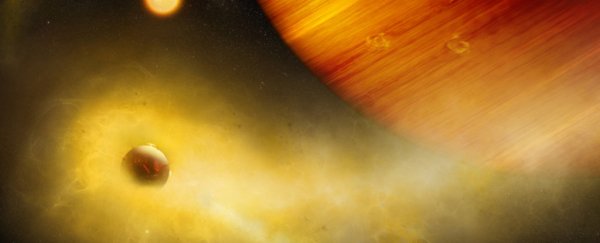Given the extravagant profusion of moons in our own Solar System, it seems likely that there are way more exomoons out there in the Universe than there are exoplanets. We're yet to conclusively find one - but astronomers just found a signal that could mean the presence of an exomoon.
Not just any exomoon, either, but something akin to a jacked-up version of the Jovian moon Io, the most volcanically active object in the Solar System.
And we really do mean jacked. Not only would the exomoon itself be covered in volcanoes spewing lava, it would be orbiting a hot planet - WASP-49b, a massive gas giant planet known as a hot Jupiter, hurtling around yellow dwarf star WASP-49 once every 2.8 days.
"It would be a dangerous volcanic world with a molten surface of lava, a lunar version of close-in Super Earths like 55 Cancri-e," said astrophysicist Apurva Oza of the Physics Institute of the University of Bern.
But don't go packing your lava suits just yet. The team didn't detect the exomoon directly. They have inferred it exists based on data from the planet itself - from stuff detected in its upper atmosphere.
When a paper describing the atmosphere of WASP-49b was published in 2017, researchers noted the presence of a thick layer of sodium at unusually high altitudes free of clouds. This sodium layer made Oza's international team look more closely.
"The neutral sodium gas is so far away from the planet that it is unlikely to be emitted solely by a planetary wind," he said.
We know, based on observations closer to home, that volcanic activity on Io produces pretty hefty amounts of potassium and sodium (among a few other things). These do not cling in significant quantities to the moon, but get swept up into Jupiter's complex magnetosphere, resulting in a torus of material ringing the planet.
We also know that, without the intense gravitational interplay between Io and Jupiter generated by the moon's elliptical orbit - the varying tidal forces that create friction and thus heat in the moon - it would not be volcanically active.
In 2006, a different team of researchers extrapolated that the presence of a torus of material around a planet could imply the presence of a moon or other orbiting body.
So, the team crunched some numbers. And they found that a volcanically active exomoon could actually release more potassium and sodium than the planet it orbits.
The sodium and potassium around WASP-49b, in the quantities and at the strange altitude detected, Oza's team concluded, could have plausibly been spewed out by a volcanic hell-moon. But it's also plausible that other processes or phenomena are responsible - a ring of ionised gas, for example.
Once again, more observation would help find answers - analysing the planet's spectrum in greater detail. Sodium and potassium lines on the spectrum are both very strong; by searching more closely, the researchers hope to find the weaker signals of other volcanic volatiles in the planet's atmosphere, such as sulphur and oxygen.
In addition, it provides yet another excellent reason to probe the atmospheres of exoplanets - a task at which we hope the next generation of telescopes will excel.
"While the current wave of research is going towards habitability and biosignatures, our signature is a signature of destruction," Oza said. "The exciting part is that we can monitor these destructive processes in real time, like fireworks."
The research has been accepted into The Astrophysical Journal, and is available on arXiv.
